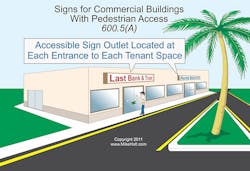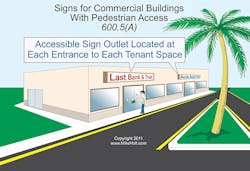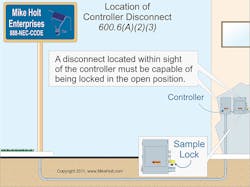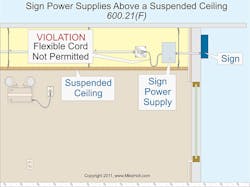Article 600 covers the installation of conductors, equipment, and field wiring for electric signs and outline lighting, including neon tubing for signs, decorative elements, skeleton tubing, or art forms [600.1]. These systems can include many lamp types, such as LED, HID, and fluorescent.
Article 100 defines an electric sign as any “fixed, stationary, or portable self-contained, electrically illuminated utilization equipment with words or symbols designed to convey information or attract attention.”
Outline lighting is an arrangement of incandescent lamps or electric-discharge lighting or other electrically powered light sources to outline or call attention to certain features, such as the shape of a building or the decoration of a window [Art. 100].
Listings and markings
All electric signs, section signs, and outline lighting must be listed, and they must be installed per the listing instructions [600.3]. Two types of lighting are exempted from the listing requirement, if field-installed:
• Skeleton tubing.
• Outline lighting, if wired according to Chapter 3.
Signs and outline lighting systems must be permanently and durably marked with the manufacturer’s name, trademark, or other means of identification [600.4(A)].
These markings don’t have to be visible after installation, but they must be visible during servicing [600.4(C)]. If located in a wet location, the markings must be weatherproof [600.4(D)]. Products that don’t comply with the marking requirements are possibly counterfeit. Don’t install them!
Branch circuits
Provide a sign outlet at the entrance of each tenant space in a commercial building or occupancy accessible to pedestrians. Supply each outlet with an individual branch circuit rated at least 20A [600.5(A)] (Fig. 1).
Branch circuits that supply signs are continuous loads [600.5(B)], so apply the 125% rule when doing your load calculations.
Branch circuits that supply neon tubing installations must be rated 30A or less. Other signs and outline lighting systems must not be rated more than 20A [600.5(B)].
The wiring for a sign must terminate at the sign or outline lighting enclosure, box, or conduit body. Poles used to support signs can contain the circuit conductors if the installation complies with 410.30(B) [600.5(C)].
Disconnects
Each circuit for a sign, outline lighting system, or skeleton tubing must be controlled by an externally operable switch or circuit breaker that opens all ungrounded conductors [600.6]. Where the circuit is a multiwire branch circuit, the switch or circuit breaker must open all ungrounded conductors simultaneously. The disconnecting means must be within sight of the sign or outline lighting system [600.6(A)(1)]. The Art. 100 definition of “Within Sight From” is: “visible and not more than 50 ft distant from the other.”
If any section of the sign or outline lighting isn’t within site of the disconnect but can be energized, you must ensure that the disconnect can be locked in the open position. The provision for locking — or adding a lock to the disconnect —must be on the switch or circuit breaker. It must remain in place whether the lock is installed or not.
What if signs or outline lighting systems are operated by external controllers? Then install the disconnect within sight of — or in the same enclosure with — the controller [600.6(A)(2)], and ensure the disconnect is capable of:
• Disconnecting the sign or outline lighting and the controller from all ungrounded supply conductors.
• Being locked in the open position. The provision for locking or adding a lock to the disconnect must be on the switch or circuit breaker. It must remain in place whether the lock is installed or not (Fig. 2).
Grounding and bonding
Bond the metal parts of signs and outline lighting systems to the transformer or power-supply equipment grounding conductor of the branch circuit or feeder supplying the sign or outline lighting system [600.7(B)(1)]. Note that the remote metal parts of a section sign or outline lighting system supplied by a remote Class 2 power supply are not required to be connected to an equipment grounding conductor [600.7(B)(1) Ex].
Use an equipment grounding conductor recognized in 250.118 [600.7(A)(1)]. The equipment grounding conductor must be sized in accordance with 250.122, based on the rating of the overcurrent device protecting the conductors supplying the sign [600.7(A)(2)].
Bonding conductors must be copper and not smaller than 14 AWG [600.7(B)(7)(1)]. Connections to the equipment grounding conductor and bonding connections must be made in accordance with 250.8 [600.7(B)(2)]. If you install bonding conductors outside of a sign or raceway, protect them from physical damage [600.7(B)(7)(2)].
The earth must not be used as the “effective ground-fault current path” required by 250.4(A)(4) and 250.4(A)(5). This is because the contact resistance of a grounding electrode to the earth is high, and very little ground-fault current returns to the electrical supply source via the earth. The result is the circuit overcurrent device won’t open and clear a ground fault; therefore, metal parts will remain energized with dangerous voltage (Fig. 3).
Location
Unless mechanically protected from physical damage, a sign or outline lighting system must be at least 14 ft above areas accessible to vehicles [600.9(A)]. Section 225.18 requires a minimum of 18 ft overhead conductor clearance above public streets, alleys, roads, parking areas subject to truck traffic, and driveways on other than residential property. This may be an important consideration if a sign is fed by overhead conductors.
Install signs and outline lighting systems so that adjacent combustible materials aren’t subjected to temperatures that exceed 194°F. An incandescent or HID lamp or lampholder must have at least 2 in. of spacing from wood or other combustible materials [600.9(C)].
Signs and outline lighting systems installed at wet locations must be weatherproof and have drain holes [600.9(D)].
Portable or mobile signs
Portable or mobile signs must be adequately supported and readily movable without the use of tools. Each portable or mobile sign is required to have an attachment plug [600.10(A) and (B)].
If installing a portable or mobile sign in a dry location, the cord can be up to 15 ft long [600.10(D)]. This helps prevent the use of extension cords. If installing portable or mobile signs in wet or damp locations [600.10((C)(1) and (2)]:
• Cords must be junior hard service or hard-service types with an equipment grounding conductor.
• The signs must have factory-installed GFCI protection.
Ballasts, transformers, and power supplies
Ballasts, transformers, and electronic power supplies must be accessible and securely fastened in place [600.21(A)]. The secondary conductors must be as short as possible. Provide a working space of at least 3 ft high × 3 ft wide × 3 ft deep for each ballast, transformer, and electronic power supply, unless installed in a sign.
Ballasts, transformers, and electronic power supplies are permitted to be installed in attics and soffits, if there’s an access door and a passageway at least 3 ft high by 22½ in. wide with a suitable permanent walkway at least 1 ft wide to the point of entry for each component. At least one lighting outlet must be installed at the usual point of entry to these spaces, and that lighting outlet must contain a switch or be controlled by a switch at the point of entry. Install a lighting outlet at or near the equipment requiring servicing [600.21(E)].
Ballasts, transformers, and electronic power supplies are allowed to be installed above a suspended ceiling, provided the enclosures are securely fastened in place. Don’t use the suspended-ceiling grid for support. Ballasts, transformers, and electronic power supplies installed above a suspended ceiling are not allowed to be connected to the branch circuit wiring by a flexible cord, because flexible cord is not allowed to be installed through, or above, a suspended ceiling [400.8(2) and (5)] (Fig. 4).
Class 2 power
In order to install Class 2 power supplies and power sources in electric signs and outline lighting, they must be listed for use with electric signs and outline lighting systems or be a component in a listed sign [600.24(A)]. The ampacity of listed Class 2 cable must not be less than the load. The cable must be at least 22 AWG. Class 2 cable in a wet location must be identified for the location [600.33(A)].
Make sure you install and support the cable so it is protected from physical damage in accordance with 300.4. If installing cables through or parallel to framing members or furring strips, protect them where they’re likely to be penetrated by nails or screws by installing the wiring method so it’s at least 1¼ in. from the nearest edge of the framing member or furring strip. If this is not possible, protect them with a 1⁄16-in.-thick steel plate or equivalent [600.33(D)].
Make any splices in a listed outlet box, and use listed insulating splicing devices. The box must be accessible after installation [600.33(B)(2)].
Signs everywhere
One of the first things you notice when entering a strip mall is that there’s a sign for every store. There are several reasons for this, including the fact that every commercial occupancy needs a form of identification, and the standard method is the electric sign. Section 600.5 of the NEC requires a sign outlet for the entrance of each tenant location that is accessible to pedestrians.
Carefully read and apply the requirements of Art. 600, and you will find that the installation of conductors, equipment, and field wiring for electric signs and outline lighting, including neon tubing for signs and skeleton tubing, is easily managed.
About the Author

Mike Holt
Mike Holt is the owner of Mike Holt Enterprises (www.MikeHolt.com), one of the largest electrical publishers in the United States. He earned a master's degree in the Business Administration Program (MBA) from the University of Miami. He earned his reputation as a National Electrical Code (NEC) expert by working his way up through the electrical trade. Formally a construction editor for two different trade publications, Mike started his career as an apprentice electrician and eventually became a master electrician, an electrical inspector, a contractor, and an educator. Mike has taught more than 1,000 classes on 30 different electrical-related subjects — ranging from alarm installations to exam preparation and voltage drop calculations. He continues to produce seminars, videos, books, and online training for the trade as well as contribute monthly Code content to EC&M magazine.




